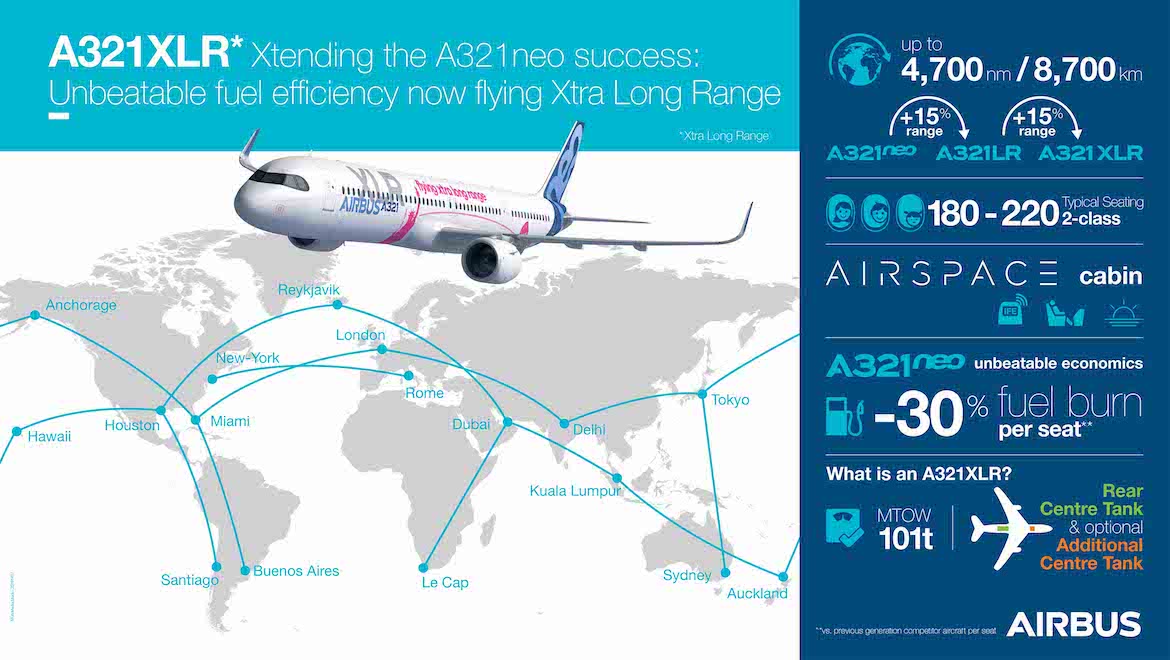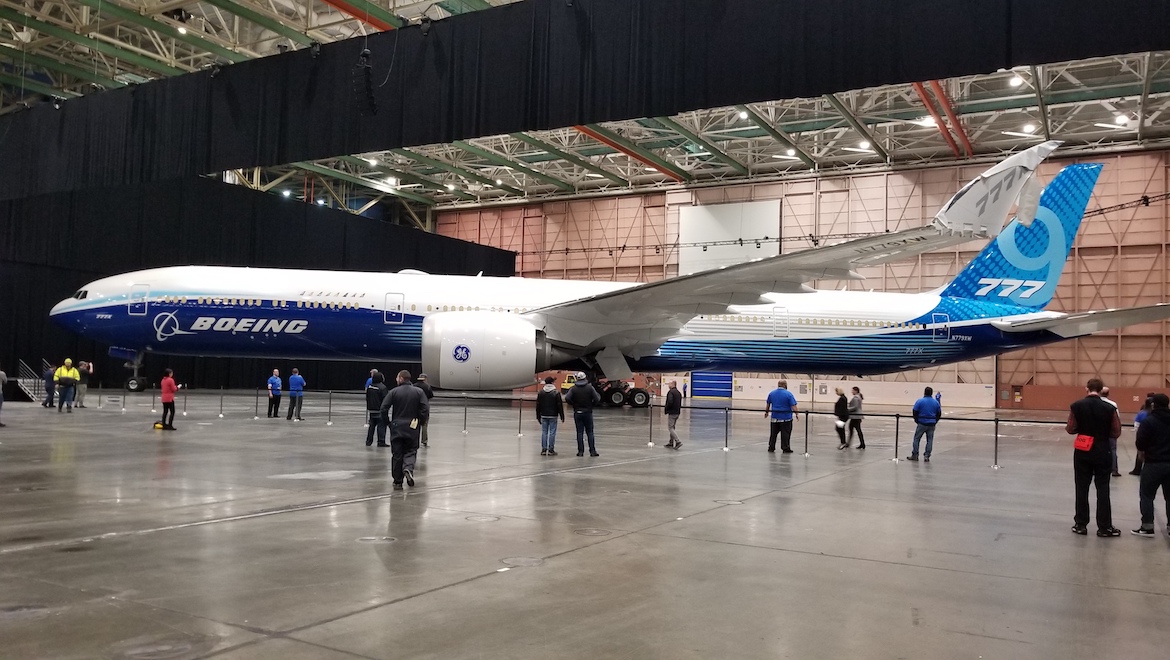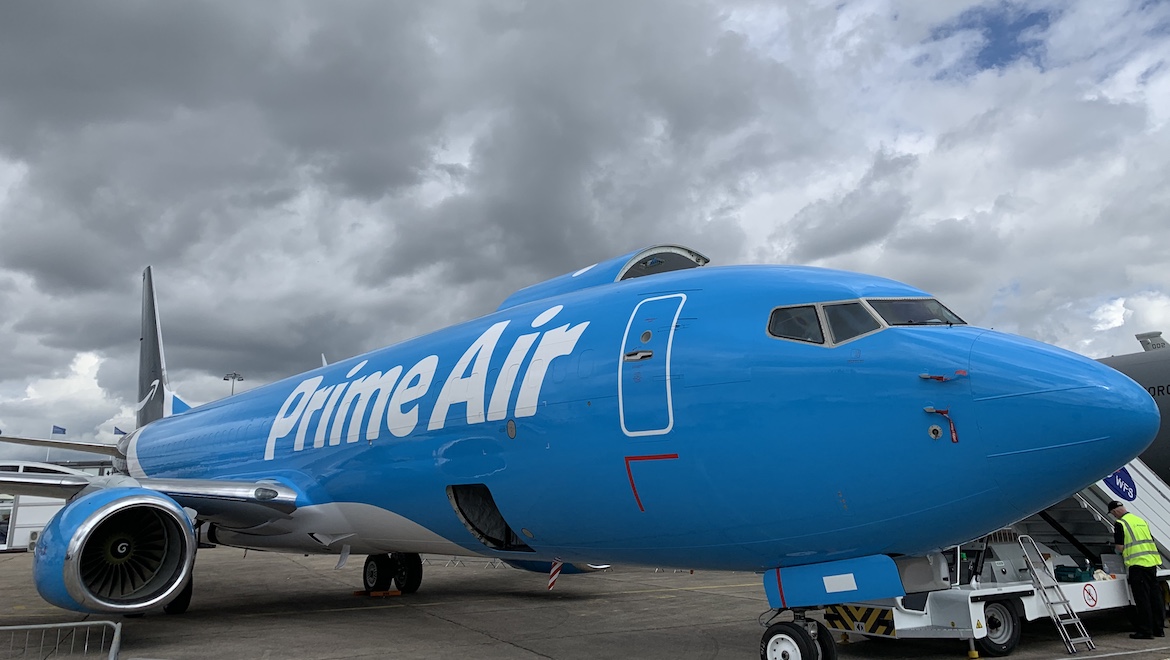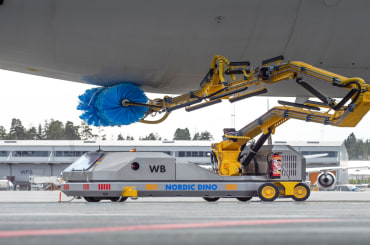Airbus officially launched its long-range A321XLR narrowbody on a busy Day 1 of the 2019 Paris Air Show, writes John Walton from Le Bourget
Airbus was always expected to dominate this 53rd Paris Air Show given both its tendency to save up orders for the Salon Le Bourget and the fact that Boeing’s ongoing problems with the 737 MAX mean that the US airframer’s plans for the middle of the market are in stasis, and that the much-mooted NMA was, as expected, not going to be launched this week.
Airbus launches A321XLR with two sets of orders
Over at the Airbus chalet on Monday (European time) the momentum was with the European airframer as it launched the predicted A321XLR version of its popular A320 family of aircraft, with a surprisingly long 4,700nm range.
“The A321XLR is the next evolutionary step from the A321LR which responds to market needs for even more range and payload, creating more value for the airlines,” Airbus said in a statement.
“With this added range, airlines will be able to operate a lower-cost single-aisle aircraft on longer and less heavily travelled routes – many of which can now only be served by larger and less efficient wide-body aircraft.
“This will enable operators to open new world-wide routes such as India to Europe or China to Australia, as well as further extending the Family’s non-stop reach on direct transatlantic flights between continental Europe and the Americas.
“For passengers, the A321XLR’s new Airspace cabin will provide the best travel experience, while offering seats in all classes with the same high-comfort as on long-haul widebody aircraft.”
Technically, the A321XLR differs from the simpler LR version in that the auxiliary centre tanks (ACT) in the hold area otherwise used by luggage and/or cargo is supplemented by a new integrated rear centre tank (RCT), installed as more of a permanent feature than the removable ACT.
Airbus chief commercial officer Christian Scherer confirmed today that the 4,700nm version requires both the ACT and RCT, but that the ACT remains removable and that Airbus will sell the RCT alone, for an as-yet-unspecified shorter range.
A modified landing gear enables an increased maximum takeoff weight of 101 tonnes, while Airbus notes that the aircraft offers “an optimised wing trailing-edge flap configuration to preserve the same take-off performance and engine thrust requirements as today’s A321neo”.
The aircraft will be delivered from 2023, and was first announced with a 27-aircraft order from Steven Udvar-Hazy’s Air Lease Corporation, which additionally ordered 23 A321neos of an unspecified subtype.
At the same time, Air Lease 50 Airbus A220-300s, nés Bombardier CSeries CS300, a vote of confidence in the newest Airbus family with the lessor stating clearly that airlines are now asking for the efficient small narrowbody airliner.
Middle East Airlines (MEA), the flag carrier of Lebanon, was named as the launch customer of the A321XLR after signing a firm order for four of the type.
We’re giving the market what it’s asking for… the #A321XLR is the longest range single aisle aircraft – available now. #PAS19 https://t.co/9qrkmtjc6b
— Guillaume Faury (@GuillaumeFaury) June 17, 2019
In an Australian context, Jetstar group chief executive Gareth Evans said on the sidelines of the International Air Transport Association (IATA) annual general meeting in Seoul on June 3 (when the type had yet to be officially launched) the A321XLR had potential to be useful within the low-cost carrier (LCC) group’s network, particularly on Australia-Japan routes.
“We have a fairly large operation out of Cairns on 787s today – an XLR potentially could enable us to grow that operation to other points in Japan out of northern Australia,” Evans told reporters.
“So it’s something we’re certainly interested in.”

New: Here’s your A321neo evolution/current portfolio recap…
• A321neo — range of approx 3,700 nautical miles.
• A321LR — a range of approx 4,000 nautical miles
• A321XLR — range of up to 4,700 nautical miles#PAS19 pic.twitter.com/KSDQpeYuNL
— Alex Macheras (@AlexInAir) June 17, 2019
A330neos for Virgin Atlantic and here with Thai AirAsia X
Virgin Atlantic placed what is believed to be its largest ever airline order for 14 Airbus A330-900neo aircraft, to replace older A330-200 and -300 jets that it uses on medium- to long-haul routes.
“The order, valued at $4.1billion, is a crucial step in Virgin Atlantic’s fleet transformation programme which will see 100 per cent of the airline’s planes replaced over a 10-year period, creating one of the youngest fleets in the skies with an average age of just 5.3 years,” Virgin Atlantic said in a statement.
“The new planes are designed to be 13 per cent more fuel and carbon efficient than the A330-300 they replace and will deliver a 50 per cent reduction in airport noise contour. Over a 10-year period, 2014-2024, the fuel efficiency of Virgin Atlantic’s fleet will have improved by 32 per cent.”
We’re so pleased to announce we’ve ordered 14 @Airbus A330neos, so we’re on our way to our cleanest and youngest fleet ever. ✈️❤️ pic.twitter.com/nAaqGMjBqm
— virginatlantic (@VirginAtlantic) June 17, 2019
Eight of the 14 aircraft will be purchased and eight leased as Virgin Atlantic looked to invest more into owning its aircraft. They will operate both business and leisure routes from the airline’s bases at London Heathrow, London Gatwick and Manchester.
Virgin Atlantic chief executive Shai Weiss said: “2019 marks a return to growth for Virgin Atlantic as we strive to become the most loved travel company and the nation’s second flag carrier at an expanded Heathrow. A fundamental part of our strategy is collaboration with partners and our announcement today with Airbus and Rolls-Royce, following the launch of our A350-1000 this summer, takes our partnership to the next level.”
The UK-based carrier can be expected to have got a superlative deal on the Rolls-Royce Trent 7000 engines that will power the aircraft, following service record of the Trents powering the airline’s Boeing 787-9 fleet, which have been so problematic that the airline procured a set of older ex-Airberlin A330-200s to fill the gaps in its schedules the Dreamliners left behind.
Thai AirAsia X also unveiled the first of the AirAsia family’s A330neos, with few surprises or indeed changes from its existing A330ceo fleet. Down the back in economy it’s the extra-tight 3-3-3 configuration with 16.5”-wide seats, while the two rows of Premium class remain angled lie-flat seats, though slightly different from the previous generation.
RED and proud! In the sea of aircraft here at the Paris Air Show 2019, our newest @Airbus A330neo shines the brightest! Say hello to the newest addition to our fleet! ✈️? pic.twitter.com/ZlttEs1cB7
— airasia (@airasia) June 17, 2019
Quiet Day 1 for Boeing
Meanwhile, Boeing’s problems continue. Its apology press conference starting off the air show did not impress many media present, with corporate apologies from multiple executives that offered “thoughts and prayers”, a phrase hugely off-key and deeply unwise given its common use in the US after mass shootings by politicians who have no intention of taking any actual action.
Unimpressive too was news from General Electric that it needed to redesign a component of the GE9X engine that will power the 777-9X, the launch model of Boeing’s re-engined large twinjet that recently rolled out of the factory. The first flight of the aircraft will thus be delayed several months, at least until the Northern hemisphere autumn, putting substantial pressure on the jet’s planned entry into service in the middle of 2020.
“We found a component inside the compressor that had more wear than we anticipated,” GE Aviation chief executive David Joyce told reporters at the Paris Air Show on Monday.
“We pushed the pause button with Boeing.”
Boeing Commercial Airplanes chief executive Kevin McAllister said he was confident the 777-9X would begin flight tests later in calendar 2019.
Questions around Emirates’ commitment to the program in the context of rumoured swaps to the stretched 787-10 and the order earlier this year of A350 and A330neo aircraft remain unanswered.
The only good passenger aircraft news for Boeing seems to be recent wins at the Lufthansa Group and Air New Zealand for the 787, and these were some time before Le Bourget.

Elsewhere on the commercial side, there was praise for the passenger-to-freighter Boeing 737-800 conversion from leasing company GECAS, which announced at the Air Show on Monday (European time) it had exercised 10 purchase rights for the converted freighter, and added a further 15 purchase rights to the deal.
Boeing has delivered 14 of the 737-800BCF aircraft since the first conversion in 2018.
“The 737-800BCF offers operators newer technology, lower fuel consumption and better reliability than other standard-body freighters. It is primarily used to carry express cargo on domestic or short haul routes,” Boeing said in a statement.
“Our leasing customers are very pleased with the versatility and reliability of these freighters,” GECAS Cargo, senior vice president and manager Richard Greener said in a statement. “It’s enabling operators to replace aging freighters and meet the rapidly growing express cargo market.”

Embraer gets last-gen E175 deal from United
Boeing’s prospective new partner, Embraer, which it intends to rename Boeing Brasil – Commercial once the proposed union is completed, secured a deal for its last-generation E175 aircraft from United Airlines for its regional connections. The deal comprised 20 firm aircraft, which will be configured with 70 seats, and 19 options.
“The E175, operated by our regional partners, has proven to be an important part of our fleet as we continue to grow our mainline airline and provide an enhanced customer experience,” United Airlines chief financial officer Gerry Laderman said.
The deal doesn’t break the order drought for Embraer’s E2 re-engined next-generation E-Jet, however. The airframer’s firm order backlog at March 31 2019 for the E2 stood at 41 E190-E2s and 112 E195-E2s, with no orders yet at this year’s show.
The #Embraer #E195E2 #ProfitHunter, the world’s most efficient single-aisle aircraft, lands in Paris. We take a first look at the #TechLion livery and the cutting edge technology on board this incredible aircraft!#PAS19 #Embraer50 #EmbraerStories pic.twitter.com/mt4KGWzLLo
— Embraer (@embraer) June 17, 2019
And finally . . .
Absolutely astounding to think that the Boeing 747’s launch range was 4,620nm, and that the #A321XLR’s is now 4,700. #PAS19 #PaxEx #avgeek pic.twitter.com/YoA7T8BNIY
— John Walton (@thatjohn) June 17, 2019
John Walton is at Le Bourget all week — follow him live on Twitter at @thatjohn.












